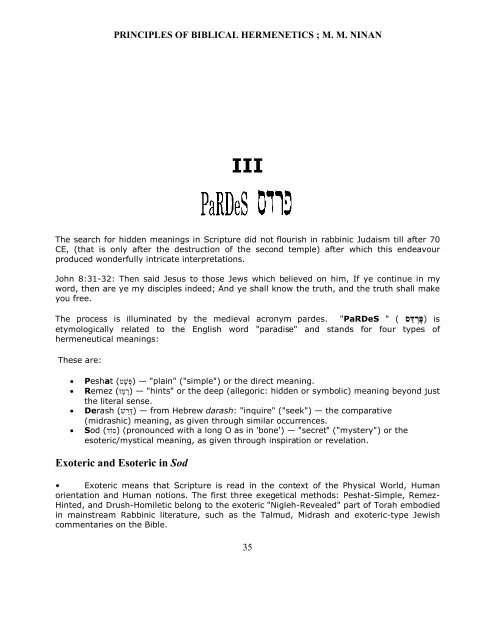Biblical Hermeneutics
Create successful ePaper yourself
Turn your PDF publications into a flip-book with our unique Google optimized e-Paper software.
PRINCIPLES OF BIBLICAL HERMENETICS ; M. M. NINAN<br />
III<br />
The search for hidden meanings in Scripture did not flourish in rabbinic Judaism till after 70<br />
CE, (that is only after the destruction of the second temple) after which this endeavour<br />
produced wonderfully intricate interpretations.<br />
John 8:31-32: Then said Jesus to those Jews which believed on him, If ye continue in my<br />
word, then are ye my disciples indeed; And ye shall know the truth, and the truth shall make<br />
you free.<br />
The process is illuminated by the medieval acronym pardes. "PaRDeS " ( דֵּס (פָּרְ is<br />
etymologically related to the English word "paradise" and stands for four types of<br />
hermeneutical meanings:<br />
These are:<br />
• Peshat (פְּשָׁט) — "plain" ("simple") or the direct meaning.<br />
• Remez מֶז) (רֶ — "hints" or the deep (allegoric: hidden or symbolic) meaning beyond just<br />
the literal sense.<br />
• Derash שׁ) (דְּרַ — from Hebrew darash: "inquire" ("seek") — the comparative<br />
(midrashic) meaning, as given through similar occurrences.<br />
• Sod (סוֹד) (pronounced with a long O as in 'bone') — "secret" ("mystery") or the<br />
esoteric/mystical meaning, as given through inspiration or revelation.<br />
Exoteric and Esoteric in Sod<br />
• Exoteric means that Scripture is read in the context of the Physical World, Human<br />
orientation and Human notions. The first three exegetical methods: Peshat-Simple, Remez-<br />
Hinted, and Drush-Homiletic belong to the exoteric "Nigleh-Revealed" part of Torah embodied<br />
in mainstream Rabbinic literature, such as the Talmud, Midrash and exoteric-type Jewish<br />
commentaries on the Bible.<br />
35


















